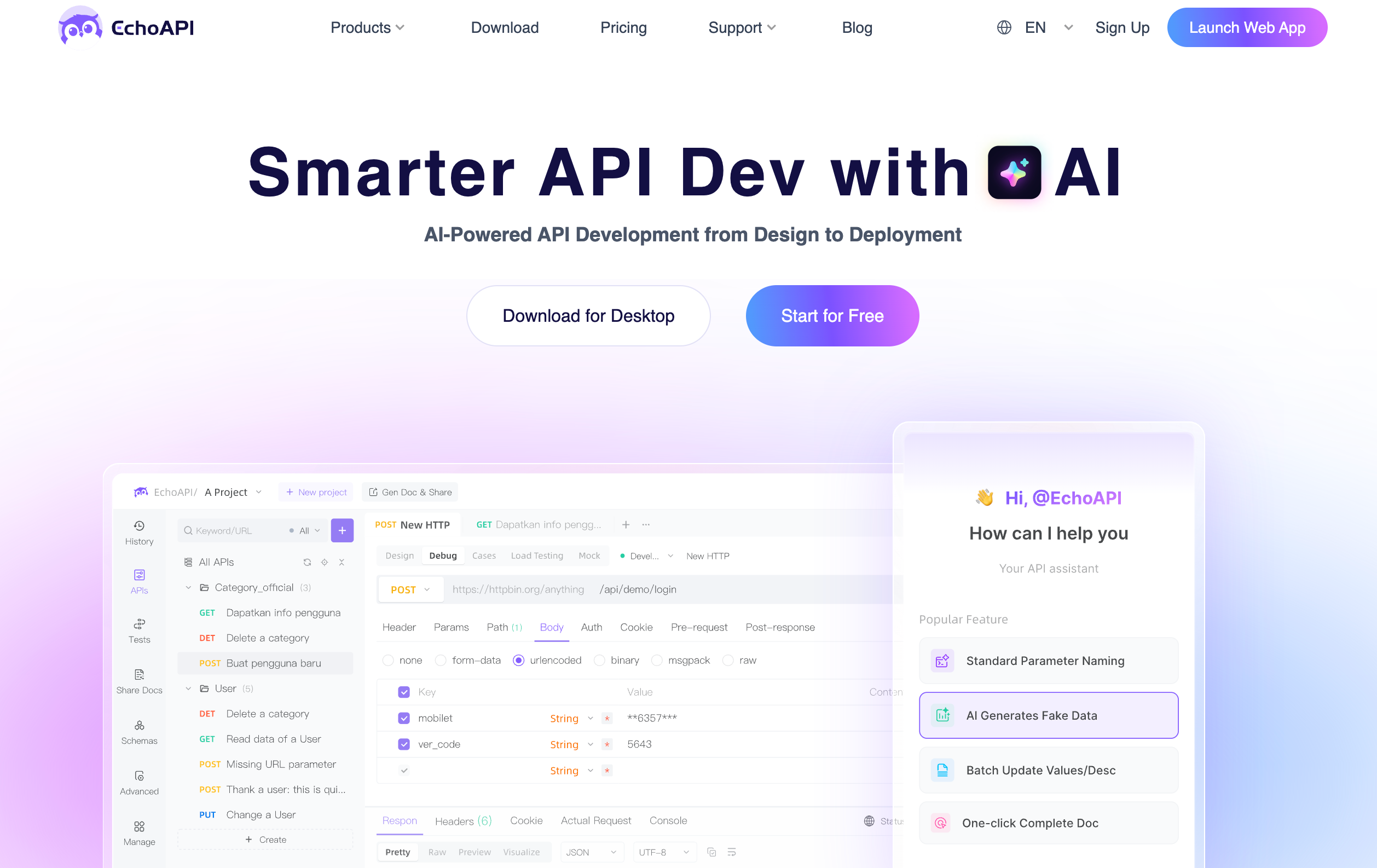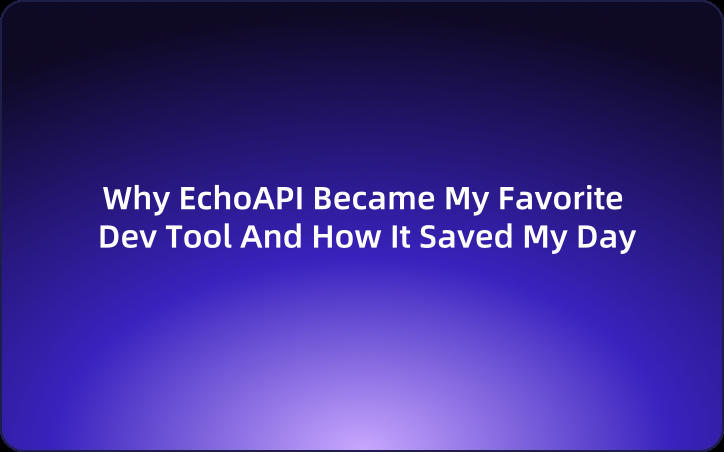Why EchoAPI Became My Favorite Dev Tool And How It Saved My Day
As a remote full-stack developer in Brooklyn, my mornings are usually a routine—until a tiny API field name threatens to disrupt everything. Here's how EchoAPI became my secret weapon to restore order.
As a remote full-stack developer based out of a Brooklyn apartment, my mornings follow a sacred ritual: grind some beans, brew a black coffee strong enough to wake up dead code, and open the holy trinity—VS Code, Slack, Notion, and of course, Chrome DevTools.
Every day feels mostly the same—until it doesn’t.
Until something small—like a single API field name—decides to ruin your whole morning.
So let me walk you through a real workday and how EchoAPI quietly became the unsung hero that turned chaos into structure and helped me claw back hours from the jaws of pointless debugging and Slack-thread archaeology.
9:15 AM – The Sync That Never Syncs
Today I’m working with Emily, one of our backend engineers, on the login flow. She pushed the updated login API last night. I fired up Postman, plugged in the params, hit “Send”—
Boom.
"Email cannot be null."
Wait, what?

Here’s what I sent:
{
"emailAddress": "mike@devmail.com",
"password": "hunter2"
}
And here’s the request payload from the OpenAPI doc she posted in Slack yesterday:
{
"userEmail": "string",
"password": "string"
}
We’re both confused. She swears the backend expects userEmail, I swear I saw emailAddress in the design doc last week. Neither of us are wrong. Neither of us are right.
Until QA chimes in:
“Hey, didn’t the latest API spec standardize it to just email?”
Yep. They did. Yesterday afternoon. Nobody told us.
Problem: Field naming inconsistency kills productivityemailAddress,userEmail, and
Welcome to API hell.
10:30 AM – QA Hits a Brick Wall
After we sort out the naming mess and I finally get the login flow working, the QA team pings me again:
“Email input is being truncated—we can’t save full addresses.”
Turns out Emily bumped the email field in the DB from VARCHAR(50) to VARCHAR(128) last week, but forgot to tell the frontend team. Meanwhile, our form validation still restricts input to 50 characters, like it’s 2004 and Gmail just launched.
Problem: Schema changes don’t propagateThe DB accepts 128 chars, but the frontend rejects anything over 50Validation logic is out of sync with backendQA test cases are failing, and worse—end users might silently get their data chopped
And no one caught it until we were already halfway through staging.
1:00 PM – EchoAPI to the Rescue
After lunch (leftover Thai and an existential crisis), I decided I was done. Done with chasing field names, digging through Slack history, and dealing with copy-pasted JSON samples from three versions ago.
A few weeks back, our team had started rolling out EchoAPI. I finally took the plunge and fully integrated it into my workflow.
Our architecture team defines reusable fields inside EchoAPI before anyone starts building. Like this:
{
"name": "email",
"type": "string",
"format": "email",
"maxLength": 128,
"description": "User's email address",
"aliases": ["userEmail", "emailAddress"]
}
- The field name is
email - Data type, format, length, and description are all enforced
- Devs reference these fields via schema links—not freehand typing
Now when I’m building UI or consuming an API, I don’t have to wonder if it’s email, userEmail, or loginEmail. It’s all in the field library. Defined once. Used everywhere.
No more “which one is correct?” Slack messages.

3:00 PM – Your Field Changed? I Already Know.
So today, our backend team updated the phoneNumber field in the user profile API—from optional to required. Classic breaking change.
Pre-EchoAPI, here’s how I would’ve found out:
- App crashes
- I panic
- Git blame
- Rage
- Send Slack DM: “yo did you change something??”
But now? I get an automatic alert from EchoAPI.
Even better: the validation schema I use in the frontend is generated from EchoAPI. So the updated field rules automatically flow into the form logic.
Problem solved: Schema changes are instantly propagated across the stackAPI docs update themselvesI get change alerts on fieldsForm validation stays in sync without manual effort
Suddenly, it feels like I’m working with a team of psychic engineers. But it’s just EchoAPI doing its job.
4:30 PM – Testing Like a Boss
Every field defined in EchoAPI includes enough metadata for test automation tools to generate real, useful cases. Take this:
{
"type": "string",
"format": "password",
"minLength": 6,
"maxLength": 32
}
EchoAPI turns that into automated test cases like:
- Missing password
- Password too short
- Password too long
- Password with weird characters (hello,
Pa$$w0rd!)
Before EchoAPI, I’d manually write 10–20 test cases just to cover these for each field. Now? They're auto-generated and integrated into our CI pipeline.
The result: higher test coverage, zero extra effort
QA loves it. I love it. Nobody’s pushing random strings into production anymore.

6:00 PM – Wrapping Up (Without Wanting to Quit)
At the end of the day, I look back and realize I didn’t once ask:
“Hey, what’s the real name of this field again?”
“Did the database schema change?”
“Why does this validation suddenly fail?”
“Is this field used in other endpoints too?”
Instead, I opened EchoAPI. Found the canonical field. Updated my code with confidence.
Summary: Why EchoAPI Rocks (Especially for API-Heavy Teams)

| Old Headaches | EchoAPI Fixes |
|---|---|
| Field name confusion | Unified field definitions |
| Surprise schema changes | Real-time field change notifications |
| Manual form logic | Auto-generated validation based on field |
| Weak test coverage | Schema-based test case generation |
| Field history is unclear | Field versioning |
Final Thoughts: It’s the Little Things That Kill (Or Save) Dev Teams
We developers can live with long hours. We’re used to juggling frameworks, toolchains, and yet another OAuth flow.
What we can’t stand is wasting hours chasing a field name, or shipping bugs because someone forgot to mention they added a maxLength to username.
EchoAPI doesn’t solve world peace.
But it does solve the silent API field chaos that ruins productivity across your stack.
It turns fields—from a messy afterthought—into structured, shared, version-controlled assets that drive consistency and clarity.
So no, you don’t need a bigger IDE. You just need fewer surprises from your JSON.
Stop letting email waste half your day.




 EchoAPI for VS Code
EchoAPI for VS Code

 EchoAPI for IntelliJ IDEA
EchoAPI for IntelliJ IDEA

 EchoAPl-Interceptor
EchoAPl-Interceptor

 EchoAPl CLI
EchoAPl CLI
 EchoAPI Client
EchoAPI Client API Design
API Design
 API Debug
API Debug
 API Documentation
API Documentation
 Mock Server
Mock Server








